Thoughts on the Mac OS X Mountain Lion Developer Preview
by Andrew Cunningham & Anand Lal Shimpi on February 19, 2012 7:40 PM EST- Posted in
- Mountain Lion
- Mac
- macOS
General Impressions: The iPad-ification of the Mac
With Mountain Lion Apple officially drops the Mac prefix to the OS, it's now simply OS X 10.8. It's interesting (and perhaps deliberate?) that Apple keeps speaking of the updates in Lion/Mountain Lion as bringing iPad features to the Mac, not just iOS features. Perhaps that speaks to the nature of the convergence we'll see going forward.
There was a time in the microprocessor business where AMD and Intel felt that the ideal architecture for low power was mutually exclusive with the ideal architecture for high performance. Over time it became very evident that what makes you power efficient often gives you great performance as well. What we saw was a unification of mobile and desktop CPU architectures as a result. Although you could argue that the same sort of product bifurcation is happening now with the popularity of smartphone SoCs, I suspect we'll eventually see more convergence there in terms of features over time.
I do wonder whether we'll see a similar transformation in the OS space. Much of the discussion has been focused around bringing iOS user experience and features to OS X, however I'm more curious about whether we'll see a more fundamental merging of the two OSes over time. Today Apple has an i and an X line of operating systems, but what's to say that we won't see an eventual unification there. In many ways this would be a motivation for OS X on ARM, but it's a similar (and possibly a stronger) motivation for iOS on x86.
For this developer preview, the download and installation processes are identical to Lion - you still get the OS from the Mac App Store, it still creates a recovery partition for diagnostic and reinstallation purposes, and it still looks and acts mostly the same. If you made a USB or DVD installer for Lion from the App Store installer, that method continues to work here.
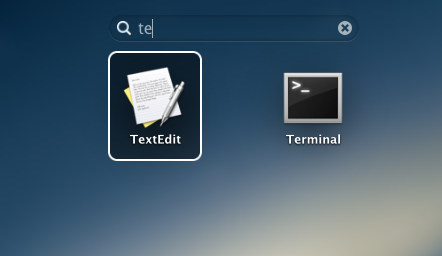
The Mountain Lion Finder, along with Lion additions like Launchpad and Mission Control, are at this point largely identical to their Lion counterparts. There are two obvious new features right now: first, Launchpad now includes a search box at the top of the window that lets you browse your installed apps. Compared to Spotlight, I find it to be of dubious usefulness, but I'm already on the record as finding the whole Launchpad concept to be of dubious usefulness - take my opinion as you will.
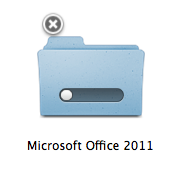
The other addition is also vaguely iOS-ish - you can cancel file copy operations in progress by clicking an X in the icon's upper left-hand corner (see above). Once a copy operation is complete, you delete the files by dragging them to the Trash just as before.
Safari 5.2
Safari 5.2, which is also currently available to developers as a beta for Lion, bumps the browser's WebKit version to 535.18.5, and brings with it some performance improvements and features. Features first: tabs now work as they do on the iPad, with each tab taking up an equal amount of space across the window - in Safari 5.1 and most other desktop browsers, new tabs are a fixed width (in both cases, the tabs begin to contract as you open more of them).
The address bar and search bar in the new Safari are also unified (as in Chrome and IE) - when you begin typing, the browser will search your default search engine, your bookmarks and history, and the content on the current page for matches. The Safari Reader button is now present to the right of the search/address bar at all times.
There's a new passwords manager in Safari that allows you to view and remove any stored user name/password combinations for websites you've visited. In the past this information was only accessible through the OS X Keychain but now it's available in both places.
Now, for performance - Safari 5.2 is measurably faster than Safari 5.1.3, and while it doesn't beat the latest stable versions of Firefox or Chrome in the tests below, the upgrade at least keeps Apple's default browser competitive. The problem is that this performance is a moving target - if Safari 5.2 doesn't launch before Mountain Lion's release this summer, both Mozilla and Google will have released several minor upgrades to their browsers that may help them pull even further ahead of Apple's latest. Interestingly enough the new Safari is actually faster than the latest stable build of Chrome in SunSpider but it loses everywhere else. Subjectively Safari feels fast but still not quite as fast as Chrome, although the two are much closer now.
These tests were run on a late 2010 MacBook Air, which runs a 1.6 GHz Core 2 Duo - please try to remember that before you laugh at any of these scores.

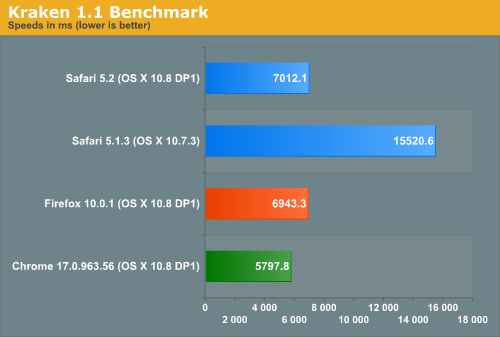
Apple Remote Desktop and Screen Sharing
The Apple Remote Desktop client in Mountain Lion has been updated to 3.6, which continues the years-long tradition of bumping the ARD version to support a new OS X release without adding enough fuctionality to justify a major version change. ARD gains IPv6 support and can now report information about batteries, trackpads, and Thunderbolt peripherals, but none of this fundamentally changes how the software works.
On a related note, Screen Sharing is made marginally more functional by the addition of controls at the top of the window - they don't really add anything that wasn't there, but they pull functionality that was previously hidden in menus and expose it to the user. Screen Sharing also supports drag-and-drop file sharing between connected computers, something previously limited to the full Apple Remote Desktop package.



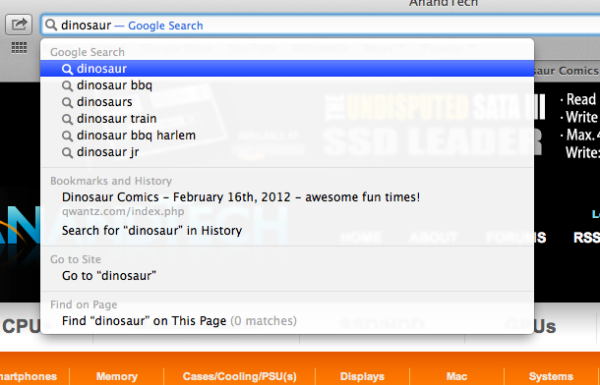
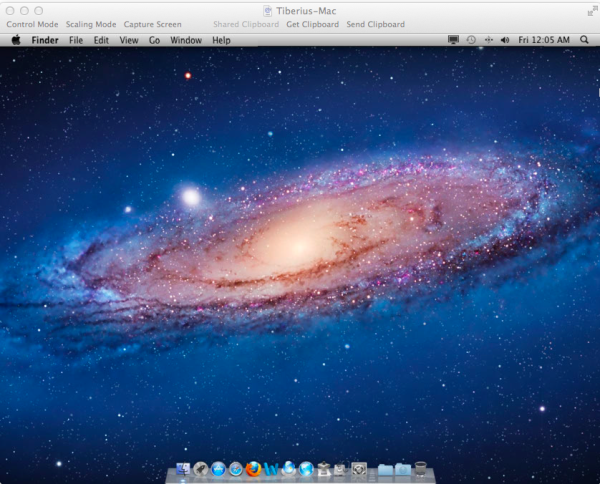








96 Comments
View All Comments
tipoo - Sunday, February 19, 2012 - link
Safari seems like the last of the major browsers apart from Chrome (which does have it, but buried in the settings) that fails at GPU acceleration, even on mac. Is that any different this time?Guspaz - Monday, February 20, 2012 - link
Chrome buries it in the experimental settings because it's still experimental. In my case, it provides a massive performance improvement to Chrome for even simple use like scrolling pages, but causes Chrome to crash far more often...I really hope they get it done soon, it makes a big difference.
tipoo - Sunday, February 19, 2012 - link
I can't help but feel Apple is headed towards an App store only distribution model for Macs like it is on iOS. Gatekeeper currently lets you choose where apps can come from and lets you still install any programs if you turn it to the most lenient setting, but what about a few years down the line when developers are all onboard the program and Apple feels comfortable enough to stop external sources?solipsism - Sunday, February 19, 2012 - link
If that were the case then why give us that middle option as it will make it harder to remove in the future?sbmassey - Monday, February 20, 2012 - link
Apple still supports Mac Ports, still provides the Terminal application, and still provides the free "Developer Tools" IDE. Given that pretty much all iOS and OSX software development uses some of these tools, I'm pretty sure that Apple is not going to go into full lockdown any time soon.MobiusStrip - Tuesday, February 21, 2012 - link
No, they'll just throw an assload of FUD up on the screen and disable the installation of any app that's not from the App Store by default, even if other options are buried somewhere.chaise2jardin - Wednesday, February 22, 2012 - link
You will have to jailbreak your OSX ! How pathetic....TEAMSWITCHER - Thursday, February 23, 2012 - link
Yes, but in this case Apple has provided the radio button to do it.Bozzified - Sunday, February 19, 2012 - link
"This is another example where Apple has to carefully straddle the line between pushing everyone to the Mac App Store and not abandoning the rest of the Mac software ecosystem. I would like to see feature parity regardless of distribution model (perhaps with some restrictions) on OS X going forward, but I'm not sure that will happen."--
Not only that this won't happen.. but it is an approach that Apple is using to make sure that developers are forced into the Mac App Store. If your non-Mac app store app doesn't have access APIs reserved only for those who distribute through the App Store than you are at a serious disadvantage thus you need to make a version for the app store.
Doing so you basically scar your customers who buy directly, basically forcing you to give Apple 30% and go through the app store.
So if Apple doesn't directly cut off any software that doesn't come from them (or through them) this is the way they will most definitely force developers to give them money.
It is not matter of whether they will do it, but when. By default, deliberately, they have placed a huge warning sign already telling users that they can't run an app that's not from the App Store.. 80% of the users will never go to Preferences to check off unsigned apps and thus forcing developers to again go through the Mac App Store.
Either way, this is a disgusting Apple tactic, that locks everyone in even further into their platform under the disguise of "security".
But I guess, as time passes by, most people "loving" Apple will realize what kind of evil they have been supporting but it will be too late as it already may be.
This is the beginning of the end of the computing as we knew and grew up with it.
MonkeyPaw - Sunday, February 19, 2012 - link
Yeah, even Linux distros are going the wrong way. Rather than making powerful features available through the control panel (like advanced user management), you are only given very simple options through the GUI, and have to resort to the terminal for relatively simple things. I'm referring to Gnome3, and Unity. :(